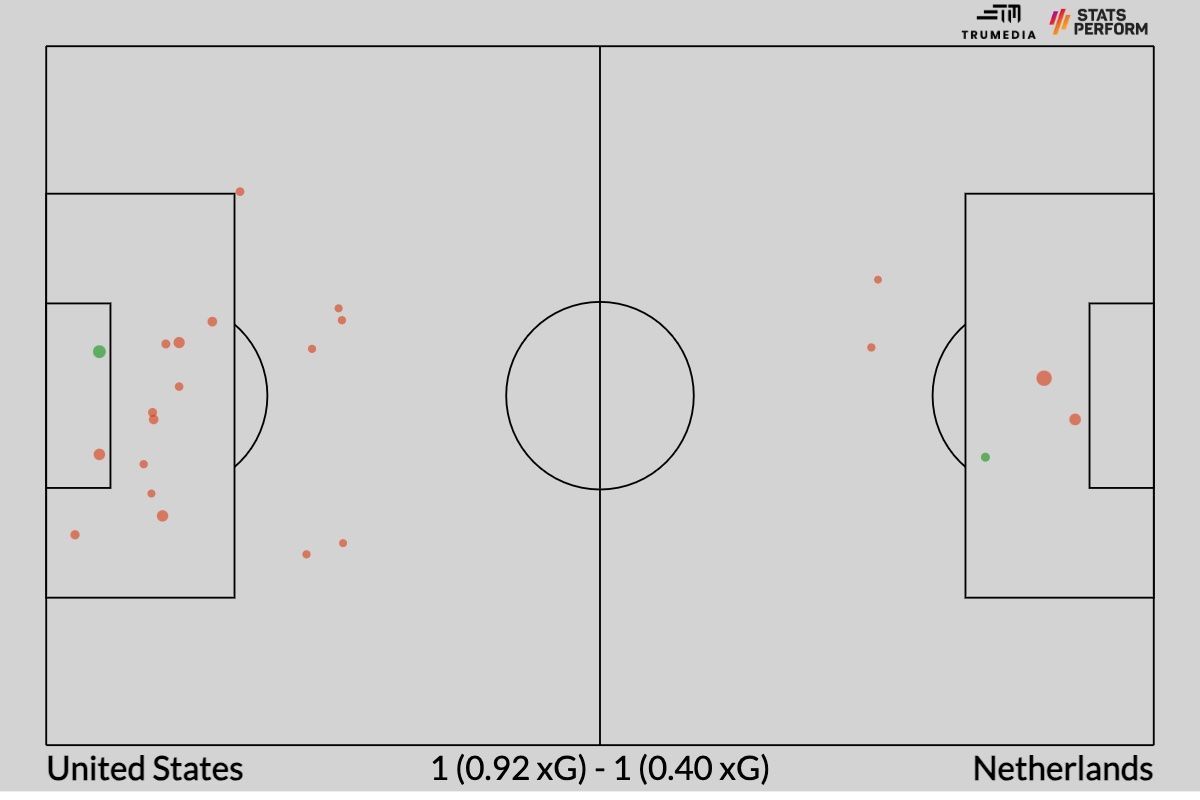Whenever an international soccer tournament starts up and some big team with lots of great players loses or draws or wins by only a goal, my mind immediately goes back to 2018.
France’s men’s team were a game away from winning the World Cup for the first time in 20 years. They’d comfortably beaten Argentina, Uruguay and Belgium in the first three knockout rounds. Teenage Kylian Mbappe was capturing the world’s attention for the first time. Paul Pogba and N’Golo Kante were the perfect midfield duo.
They were heavy favorites to beat Croatia — and a ton of people in France were still completely miserable.
For the Wall Street Journal, Stacy Meichtry and Joshua Robinson wrote a piece: “France, on the Brink of a World Cup Win, Has the Bleus.” The sub-headline: “Fans are disappointed by the team’s non-French, workmanlike approach; ‘We had to be pragmatic.'” In the piece, they quote a nurse who had called into a local radio station before the final and summed up a large chunk of the nation’s frustration with the way the team had been managed, “[Didier] Deschamps has a Ferrari in his hands and never breaks the speed limit!”
France, then, won the World Cup and scored four goals in the final.
The natural state of being for an international soccer fan is misery. You fall into one of two camps: You root for a team whose players aren’t good enough, but you convince yourself that the players are only not good enough because the manager isn’t selecting the right players. Or, you root for a team whose players are good enough but whose potential is severely limited by the structure of international soccer — short tournaments prone to randomness, limited practice time that makes it incredibly difficult to play a free-flowing attacking style — but you convince yourself that the team isn’t achieving both your aesthetic and results-based goals because the manager isn’t selecting the right players.
All of which is to say: Do not panic. Take a deep breath. The United States women’s national team is going to be fine.
Let’s start with the basics: You can’t win every game
The USWNT’s worst enemy is, well, themselves. Before Wednesday’s draw with the Netherlands, the Americans had won 13 consecutive World Cup matches. That is, to use an obscure statistical term, absolutely freaking absurd. It’s a record in the tournament, because of course it is.
To reiterate, this means that the USWNT outscored their opponents in regulation in 13 consecutive matches — at the highest possible level of competitive women’s soccer, at a time when the rest of the world has rapidly improved at playing the sport. By doing that, the likes of Alex Morgan, Megan Rapinoe and Julie Ertz created a completely false illusion of control.
You cannot control soccer. The bounce of the ball and the low-scoring nature of the sport is what makes us love it; it’s also what makes us hate it. Compared to favorites in other sports, soccer teams usually have a lower implied win percentage in a given game because there are so few goals, ties exist and you’re trying to use your feet to get the ball past the only person on the field who’s allowed to use her hands.
– Women’s World Cup: Schedule | Rosters | News
– How teams can qualify for the round of 16
After a couple of disappointing tournaments dotting the aughts, the USWNT then reached three consecutive World Cup finals and won two in a row. At the last tournament, they won all seven matches they played in regulation. While I don’t think there’s any real doubt over whether the USWNT were the best team in either of the past two tournaments, they weren’t 13-wins-in-a-row good because no team at any reasonable level of competition can ever be that good. Even if you literally have 100% of the possession, you still might not win the game.
Over the 13-game winning streak, the U.S. won five of those matches by a single goal. There’s no special skill to winning a one-goal game; one different bounce, and it’s a draw. Two different bounces, and the win streak never even happens. So, while not winning a match might feel like some massively disappointing shift in the global pecking order or whatever neuroses you want to bring into watching these matches, it’s worth taking a step back for a second.
Despite the draw against the Netherlands, the USWNT haven’t lost a World Cup match in regulation in more than 12 years. That’s three full presidential terms! It would be another nine years before anyone had even heard of COVID-19. Alyssa Thompson was six years old the last time the team she currently plays for lost a game at the tournament she is currently playing in.
Plus, it’s not like you have to run the table to win the whole thing. The Argentinian men lost to Saudi Arabia in their opening game — remember that? — before lifting the trophy last December in Qatar. In fact, it’s likely that the winner of the World Cup drops points in the group stages. Here are the previous five winners of the women’s World Cup, with their point totals from the opening round:
– 2003: Germany, 9 points
– 2007: Germany, 7 points
– 2011: Japan, 6 points
– 2015: United States, 7 points
– 2019: United States, 9 points
Oh, and one other thing: The USWNT are still leading their group.
Okay, but I don’t like how it looked!
We’ll start with the Vietnam match. Yes, the U.S. Thailand — then obviously this year’s team is terrible. They’ve declined by 10 goals over four years. Pathetic! But, well, three goals is close to the minimum number of goals we’d expect the USWNT to score from the chances they created against Vietnam.

With slightly better finishing, this game ends 4-0 or 5-0 or 6-0, and everything is fine. Getting stuck on the number of goals scored also ignores the barely believable aspect of this game: The USWNT allowed zero shots and zero touches inside their own penalty area.
While most games have a vast array of potential outcomes based on the chances created by both teams, this one actually didn’t. There was essentially no world — outside of Naomi Girma deciding to rip a couple of shots at Alyssa Naeher — where the USWNT could have lost this game. Considering Vietnam didn’t attempt a shot, they could not have scored. And considering they never even touched the ball inside the penalty area, it’s not like they could’ve drawn a penalty, either.
Obviously the USWNT have a massive talent advantage over Vietnam, but if it were easy to create that many chances without conceding anything on the defensive end, more teams would do it. In fact, in all the World Cup matches since 2011 (which is as far back as the data goes), no team has ever done it. Against Vietnam, the U.S. had 100% of the shots and 100% of the penalty-area touches.
Now, if that wasn’t enough to convince you, then Wednesday night certainly didn’t do anything to change your mind. I don’t even think the USWNT played particularly well. Their press was a mess in the first half, they struggled to control the ball for long stretches, manager Vlatko Andonovski strangely only used one sub despite having the deepest roster in the tournament … and yet they completely dominated the balance of chances and should’ve beaten the defending World Cup runners-up and the ninth-ranked team in the world.

The main story of the match with the Netherlands is incredibly annoying and simple, but it’s true: The Netherlands scored with their first shot of the game. Or, the USWNT conceded a goal from the first shot they allowed in the tournament. Once that happens, the team with the lead no longer has to be as aggressive with the ball and the dynamic of the match totally shifts. In a club season, we have enough games that these score effects come out in the wash, but at an international tournament, there are so few games and therefore early goals can completely skew our perception of a team’s performance.
Against the Dutch, the U.S. attempted 18 shots and only conceded five. The shots they attempted weren’t particularly high quality, but that’s not because they weren’t working the ball into dangerous areas. No, they took 33 touches inside the penalty area (tournament average is 22) and conceded just 12. Play this exact game with these exact same chances for both teams 100 times, and the U.S. wins more often than not. Play this exact game with the exact same possession patterns 100 times, and the U.S. likely generates even better chances from all those touches in the box. The Dutch, meanwhile, pretty much maxed out the reasonable number of goals they could’ve scored from their limited number of attempts and dangerous possessions.
Now, this isn’t to say that the USWNT are a perfect team. I really don’t understand the lack of subs. An older and much more stagnant Morgan has, at times, looked out of place within a lineup that is otherwise incredibly dynamic. And they’ve only completed 71% of their passes, which is just the 15th-highest mark in the tournament so far. Despite lots of turnovers, they haven’t had an issue controlling games, but what might happen when they come up against a savvy passing team like Spain that won’t give you the ball back once you lose it?
Ultimately, though, the story of the USWNT’s World Cup so far is that they’ve scored with 8.7% of the shots they’ve attempted and conceded from 20% of the shots they’ve allowed. The average conversion rate at the last World Cup was 11%. Unless you think that the most successful nation in women’s soccer history has suddenly produced a new generation of players that are good at everything else but terrible at converting and saving shots, then we should expect the USWNT to regress toward the average rates on both ends.
The U.S. still has Lindsey Horan, who might be the best player in the world. At least, I’ve never seen a more complete midfielder while in possession — at any level. Sophia Smith is as good as it gets on the wing. Crystal Dunn completed nearly as many progressive passes as the entire Dutch team on Wednesday. Rose Lavelle is still coming off the bench. And the big question mark coming into the tournament — the defense — has been fantastic through two games, with Girma and Ertz somewhat unexpectedly partnering at center-back.
And so all the consternation just leads back to here. The USWNT remain the betting favorites to win the World Cup. Their odds haven’t really budged; they’re significantly less likely than 50-50 to take home their third straight trophy. And so nothing has really changed. They’re the most likely team to win the World Cup, but it’s more likely that someone else wins. Despite what’s happened in each of the past two tournaments, it’s always been that way.



